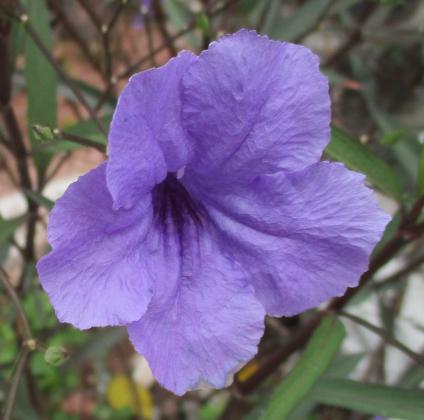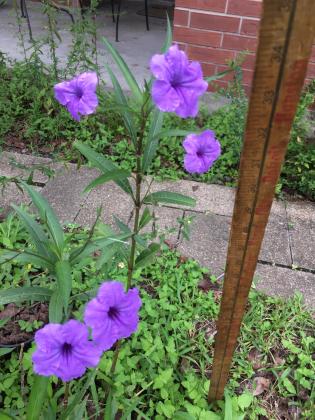Ruellia simplex – Too many names but good in a rain garden
Backyard Horticulture
Ruellia simplex, Mexican petunia, is native to Mexico and South America, but has naturalized in the southern U.S., the Caribbean, and sub-tropical and tropical regions. I don’t know why this plant has so many names, but if you research it, you should also check the following synonyms: R. brittoniana, R. coerulea, R. malacosperma, R. tweediana, and Cryphiacanthus angustifolius. They all refer to R. simplex. There are also several cultivars, which include dwarfs and pink, purple, and white varieties.
The genus, Ruellia, is named for French botanist Jean Ruelle (1474 - 1537). The species name refers to the simple, not compound, leaves. The common name, Mexican petunia, is half correct. The plant is from Mexico, but it is not a true petunia, which is in the genus Petunia. It just resembles one.
This article is about the tall plant with purple flowers. It is common in Grimes County gardens, often growing along a fence. Sometimes it weaves itself into another plant such as a hedge making it look like the hedge has purple flowers. Or, you might see several growing together in a large clump. The plant is drought-tolerant but often found along waterways such as ponds and drainage ditches. It’s known as riparian, a plant located on the bank of a natural watercourse. Frogs often live at the base of Mexican petunias when it grows near the water. The leaves are food for caterpillars and hummingbirds and it’s a host plant to butterflies.
A perennial, it’s about 3-feet high, evergreen, with a square-ish stem. Where the leaves are attached, the stem has joints called nodes. The stem is usually hairless when young, except there may be some tufts of hair at the nodes. The stem becomes slightly woody and may get more hair as the plant gets older.
Lance-shaped opposite leaves are up to 12-inches long and a little less than an inch wide. They and the stem sometimes have a bronze or purple tinge or streaks. The purple funnel or trumpet shaped flowers are delicate and showy with five crinkly petals. Individual flowers last only one day, but there are always new ones opening. Fruit is a cigar-shaped capsule, up to 1-inch long, containing four to 20 small, flat, round seeds. Seeds are dispersed when the capsule explodes, throwing them almost 10 feet. When they get wet, seeds exude a sticky, mucilaginous gel. Animals and birds spread the seeds when the gel sticks to them. Mexican petunia seeds don’t need to go through a period of cold, nor do they need scarification, seed coat damage. Without a dormancy mechanism, seeds are ready to germinate almost immediately after leaving the capsule.
The National Institutes of Health, ncbi.nlm.nih.gov, has an illustrated article “Shooting Mechanisms in Nature: A Systematic Review” explaining how this plant and other life forms reproduce by sending seeds away from the parent. “This review offers insight into the working principles of shooting mechanisms in fungi, plants, and animals ... The seeds of R. simplex are thrown for distances of up to 3 [meters] with a launch angle of 40°.”
Another way the plant spreads is by underground rhizomes and stem segments at the nodes where the leaves are attached. Both seeds and rhizome pieces will float in water. It is often flood water that spreads the plant. It forms large clumps by spreading roots that are hard to kill. It can become a multi-stemmed shrub instead of individual flowers. People trying to get rid of the plant spread it by pulling it up and throwing it someplace other than the compost pile. And, you must be sure you get all of the underground rhizome, as the plant will regrow if you miss a piece.
In traditional medicine systems plants in the Ruellia genus have been used for bladder, heart, and other ailments. The Semantic Scholar, semanticscholar.org, has a paper published by the Polish Pharmaceutical Society, “Genus Ruellia: Pharmacological And Phytochemical Importance In Ethnopharmacology.” The paper used the synonym R. brittoniana. “In pharmacological investigation, extracts of Ruellia brittoniana and Ruellia patulawere were used for cardiovascular screening. The cardiovascular experiments were carried out in vitro and in vivo ... The review places emphasis on genus Ruellia and elaborates the biological and phytochemical studies and medicinal uses in various ailments. This genus is well studied in its biological and phytochemical aspects. The future work required is to isolate the active biological compounds which are responsible for these activities and may serve as drugs for different ailments. Now it is time to bring genus Ruellia from herbal market to the health commercial market.”
A way this and other plants can be enjoyed is in a rain garden. A Texas A&M AgriLife, agrilifecdn.tamu.edu, article had a definition, “A rain garden is a planted shallow depression that collects rainwater runoff from roofs, parking lots, and other surfaces. While a rain garden can blend into the landscape and serve as a garden area, its main function is to retain and treat collected storm water. Rain gardens (also known as bioretention areas) are either bowl-shaped or surrounded by berms to retain water. They are typically planted with native or adapted vegetation that tolerates both waterlogging and drought.” The title is “Stormwater Management: Rain Gardens.” There are instructions on how to build, operate and maintain a rain garden, as well as a suggested plant list. The Mexican petunia is listed under the synonym R. brittoniana.
Deborah Richardson is a freelance reporter for The Examiner with a fondness for flora in its natural setting.


